Sidechaining and ducking – something that used to be relatively difficult with hardware compressors but is now really easy in software – here’s how to do it in VCV Rack, with a file to download below.
See also: Studio Brootle 909 Sample Pack, House Drum Patterns, VCV Rack Tutorial.
How to Sidechain in VCV Rack…
- Use the Bog Audio DADSR(H) envelope generator to modulate a VCA.
- Trigger the DADSR (H) with the same signal as the kick.
- With the inverted envelope setting the envelope will duck the signal when the kick hits.
Here’s an example with just a long tone and a kick drum – notice that the long tone is continuous until the kick comes in and then the tone ducks / drops on volume when each kick hits. This is really useful on basslines so that the bass and kick do not interfere with each other.
This is explained in full below…

What is sidechain compression?
Sidechain compression, also known as ducking, is when one audio signal reduces the level of another. i.e. on a radio show when the DJ talks and the music drops in volume when they talk but comes back in immediately when they stop talking. Also used for a number of mixing techniques in music production.
How producers use sidechaining
It’s used in dance music normally to separate the kick and the bass line so they don’t play at the same time, or the kick can get lost in the mix. On some tracks, almost all most channels are ducked off the kick, like in some Daft Punk tracks and on a lot of pumping house tracks for example. It makes the whole track pump.
This traditionally was done with a compressor on the bassline that took the input from the kick and ducked the volume when the kick played.
VCV Rack Sidechain file – download here:
Download the file and you can hear the tone running. When you press Q on your keyboard to run the drum sequencer you can hear the tone dropping in volume.
How to sidechain with free modules
In this VCV Rack example there is an envelope and VCA to do the same thing as a compressor normally would – to duck. The envelope is triggered by the kick and drops the volume of the VCA when the kick plays. The Bog Audio DADSR(H) is good for this – it is an envelope generator, but it has a feature where you can invert the envelope, which is ideal for what we need.

A description of the modules used
Row 1: a simple kick drum beat with a Drum Sequencer (clocked by Gnome) and Trummor2 as the kick drum sound source.
Row 2: The VCO-1 makes a tone. This is sent through a VCA-2 unit that sets the volume for the tone. Then the DADSR(H) module modulates the VCA (the volume of the tone).
The kick channel on the Drum Sequencer is also routed to the trigger the DADSR(H) envelope. This mean the envelope will fire at the same time as the kick from the sequencer, and because this is inverted, it drops the volume on VCA-2 when the kick hits. Which is the sidechaining/ducking effect we want.
I used the DADSR(H) in inverted mode – I want it to do the exact negative/opposite of an envelope. I don’t want it to open up the VCA momentarily and then close it, but I want it to close it momentarily.
Trance Gate in VCV Rack
You can also use this sidechain techno it to gate pretty much anything – i.e. if you have a pad and you want to gate it, or make it lower in volume rhythmically, you can sidechain it to a kick too. You can even go a step further and make a second kick channel and mute it so you cannot hear it, and use that kick just for side chaining.
This then means you make pretty much any kick sequence you like to gate the pad in nice rhythmic patterns for example.
This technique is used in trance a lot – often called a trance gate…
So to make a trance gate in VCV Rack you use the sidechain example above on a pad, but mute the kick so you cannot hear it. But then you put the kick on every even step of a 16 step sequence, i.e. 2,4,6,8,10,12,14,16. You may then need to tweak the envelope settings so that its very short. And you’ll get a rhythmic gating effect on the pad.
You can obviously tweak the kick pattern and envelope settings for different effects. This is useful beyond just the trance gate effect. You hear this used a lot on drone music and in drones in techno. And it has applications in pretty much any type of music to be honest – you can use gating like this on drums and drum loops even, and especially on reverb sends.
Some more things to try:
You can play with the REL on the DADSR(H) to tweak the ducking length.
More advanced things to try: set the ducking up on a reverb for sidechained reverb. You can also set up a muted kick channel with whatever pattern you want and use it for creative gating style fx. You can do what you want as the kick cannot be heard. Obviously you can use the sidechaining on a kick and sub bass to mix it better. Also using the envelope to trigger a filter rather than volume / VCA can be a good tool for for kick/bass mixing.
You might like our other VCV Rack articles: Techno Rumble Kick, Acid House, and Acid Techno Patch, also see our other Studio Technique articles and our other VCV Rack Patches.
If you do anything good with this file let us know. To contact us – message us on Instagram… Please give us a follow there too: https://www.instagram.com/studiobrootle/
We offer online Ableton lessons, get in contact to get the most out of your studio time: Ableton Lessons.